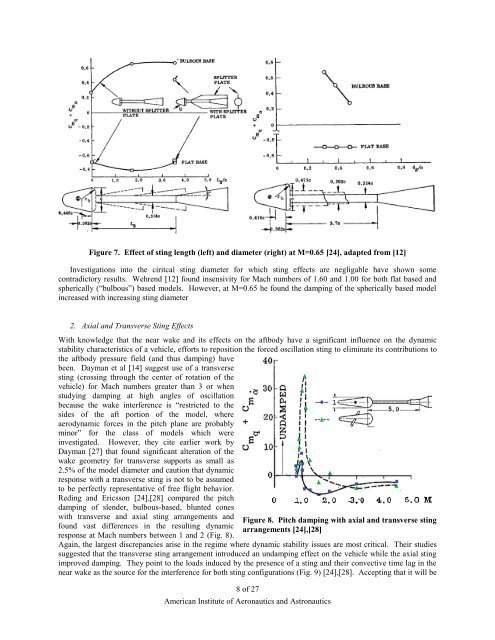Survey of Blunt Body Dynamic Stability in Supersonic Flow
Survey of Blunt Body Dynamic Stability in Supersonic Flow
Survey of Blunt Body Dynamic Stability in Supersonic Flow
Create successful ePaper yourself
Turn your PDF publications into a flip-book with our unique Google optimized e-Paper software.
Figure 7. Effect <strong>of</strong> st<strong>in</strong>g length (left) and diameter (right) at M=0.65 [24], adapted from [12]<br />
Investigations <strong>in</strong>to the ciritcal st<strong>in</strong>g diameter for which st<strong>in</strong>g effects are negligable have shown some<br />
contradictory results. Wehrend [12] found <strong>in</strong>sensivity for Mach numbers <strong>of</strong> 1.60 and 1.00 for both flat based and<br />
spherically (“bulbous”) based models. However, at M=0.65 he found the damp<strong>in</strong>g <strong>of</strong> the spherically based model<br />
<strong>in</strong>creased with <strong>in</strong>creas<strong>in</strong>g st<strong>in</strong>g diameter<br />
2. Axial and Transverse St<strong>in</strong>g Effects<br />
With knowledge that the near wake and its effects on the aftbody have a significant <strong>in</strong>fluence on the dynamic<br />
stability characteristics <strong>of</strong> a vehicle, efforts to reposition the forced oscillation st<strong>in</strong>g to elim<strong>in</strong>ate its contributions to<br />
the aftbody pressure field (and thus damp<strong>in</strong>g) have<br />
been. Dayman et al [14] suggest use <strong>of</strong> a transverse<br />
st<strong>in</strong>g (cross<strong>in</strong>g through the center <strong>of</strong> rotation <strong>of</strong> the<br />
vehicle) for Mach numbers greater than 3 or when<br />
study<strong>in</strong>g damp<strong>in</strong>g at high angles <strong>of</strong> oscillation<br />
because the wake <strong>in</strong>terference is “restricted to the<br />
sides <strong>of</strong> the aft portion <strong>of</strong> the model, where<br />
aerodynamic forces <strong>in</strong> the pitch plane are probably<br />
m<strong>in</strong>or” for the class <strong>of</strong> models which were<br />
<strong>in</strong>vestigated. However, they cite earlier work by<br />
Dayman [27] that found significant alteration <strong>of</strong> the<br />
wake geometry for transverse supports as small as<br />
2.5% <strong>of</strong> the model diameter and caution that dynamic<br />
response with a transverse st<strong>in</strong>g is not to be assumed<br />
to be perfectly representative <strong>of</strong> free flight behavior.<br />
Red<strong>in</strong>g and Ericsson [24],[28] compared the pitch<br />
damp<strong>in</strong>g <strong>of</strong> slender, bulbous-based, blunted cones<br />
with transverse and axial st<strong>in</strong>g arrangements and<br />
found vast differences <strong>in</strong> the result<strong>in</strong>g dynamic<br />
response at Mach numbers between 1 and 2 (Fig. 8).<br />
Figure 8. Pitch damp<strong>in</strong>g with axial and transverse st<strong>in</strong>g<br />
arrangements [24],[28]<br />
Aga<strong>in</strong>, the largest discrepancies arise <strong>in</strong> the regime where dynamic stability issues are most critical. Their studies<br />
suggested that the transverse st<strong>in</strong>g arrangement <strong>in</strong>troduced an undamp<strong>in</strong>g effect on the vehicle while the axial st<strong>in</strong>g<br />
improved damp<strong>in</strong>g. They po<strong>in</strong>t to the loads <strong>in</strong>duced by the presence <strong>of</strong> a st<strong>in</strong>g and their convective time lag <strong>in</strong> the<br />
near wake as the source for the <strong>in</strong>terference for both st<strong>in</strong>g configurations (Fig. 9) [24],[28]. Accept<strong>in</strong>g that it will be<br />
8 <strong>of</strong> 27<br />
American Institute <strong>of</strong> Aeronautics and Astronautics
















